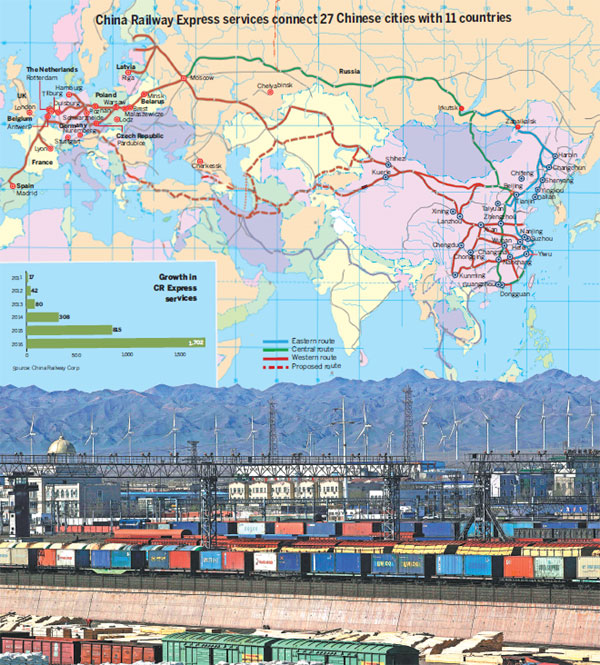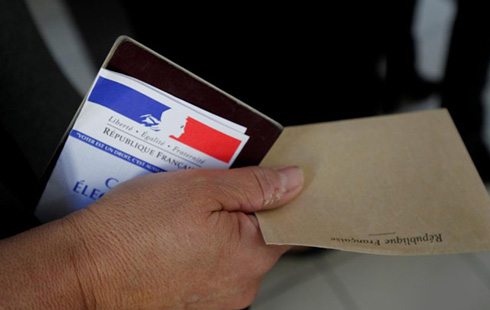CR express carries weight of expectations
|
China Railway Express services connect 27 Chinese cities with 11 countries Chen Jian / For China Daily 【Check the whole page of file】 |
Rail freight services linking Chinese cities with destinations across Eurasia seen as critical to boosting trade and economic ties
The trees and plants exported by Sichuan Heshengde Import and Export Trade Co used to spend up to 35 days in transit before they reached their destination markets in Europe.
After being loaded onto a truck at the company's base in Chengdu, capital of Sichuan province, the plants were driven to Xiamen Port on the southeast coast and transferred to a ship, which crossed the Indian Ocean and the Red Sea before docking in Europe.
Things changed in December, however, when the company switched to using a China Railway Express freight service that travels between Chengdu and the Dutch city of Tilburg in just 13 days.
"It's not only cut the travel time, but also wastage," said Gao Yunfei, assistant to Heshengde's general manager. "The rail journey has increased the survival rate of our plants by 10 percent compared with the previous shipping method.
"The plants also look much better, which means they can be sold at a higher price," he added.
To date, the company has shipped nine containers loaded with money tree plants, Chinese banyan or white willow on the freight service. Most containers are about 12 meters by 2 meters by 2 meters.
Gao said about half of Heshengde's exports now travel by train. "The price is higher, but considering the time and reduced wastage, the cost is about the same as by sea," he said. "It depends on our customers' requirements, but as the supplier, we prefer rail."
The CR Express network is helping companies throughout China and neighboring countries to improve their trade with markets in Central Asia and Europe.
China launched its first cross-border rail freight service - between Chongqing and Duisburg in Germany - in March 2011. Since then, the number has risen to 51, connecting 27 Chinese cities with 28 destinations in 11 countries.
Some 3,557 outbound and inbound journeys had been made on these routes, and that figure is expected hit 5,000 by 2020, according to a five-year development plan for the CR Express released in October by the National Development and Reform Commission.
Seventeen Chinese cities have regular scheduled services, with the busiest being Chengdu, where 10 trains depart every week. The other 10 offer chartered services.
The shortest run is between Chengdu and Lodz in Poland, which takes 12 days, while the longest starts in Yiwu in Zhejiang and ends in Madrid, covering 13,052 km in 18 days.
CR Express services utilize three key border ports: Manzhouli in the Inner Mongolia autonomous region, the eastern gateway; Erenhot in Inner Mongolia, the central gateway; and Alashankou and Khorgos in the Xinjiang Uygur autonomous region, which form the western gateway.
As a logistical option, rail freight is faster than by sea and cheaper than by air, according to the network operator, China Railway Corp, which says almost all services arrive on time. Prices are not publicly disclosed.
Plan to rebrand
China's first cross-border freight services were launched by local railway authorities, with a route's name usually made up of the departure city, the border port and the destination: Chongqing-Xinjiang-Europe, for example.
Last year, the NDRC rebranded all services as CR Express as part of its development plan, which highlighted the rail links as crucial to the Belt and Road Initiative.
First proposed by President Xi Jinping in 2013, the initiative comprises the Silk Road Economic Belt and the 21st Century Maritime Silk Road, and aims to boost trade and investment between China, Central Asia, the Middle East, Europe and Africa.
Logistics services are seen as a physical link connecting Eurasia that could prove the cornerstone for strengthening economic ties. However, the development plan states that better regulation is urgently needed to deal with the high costs, disorderly competition, inefficient customs clearance, and unsuitable infrastructure.
The plan sets a target to have three gateways and 43 transit hubs as part of the CR Express network by 2020.



























